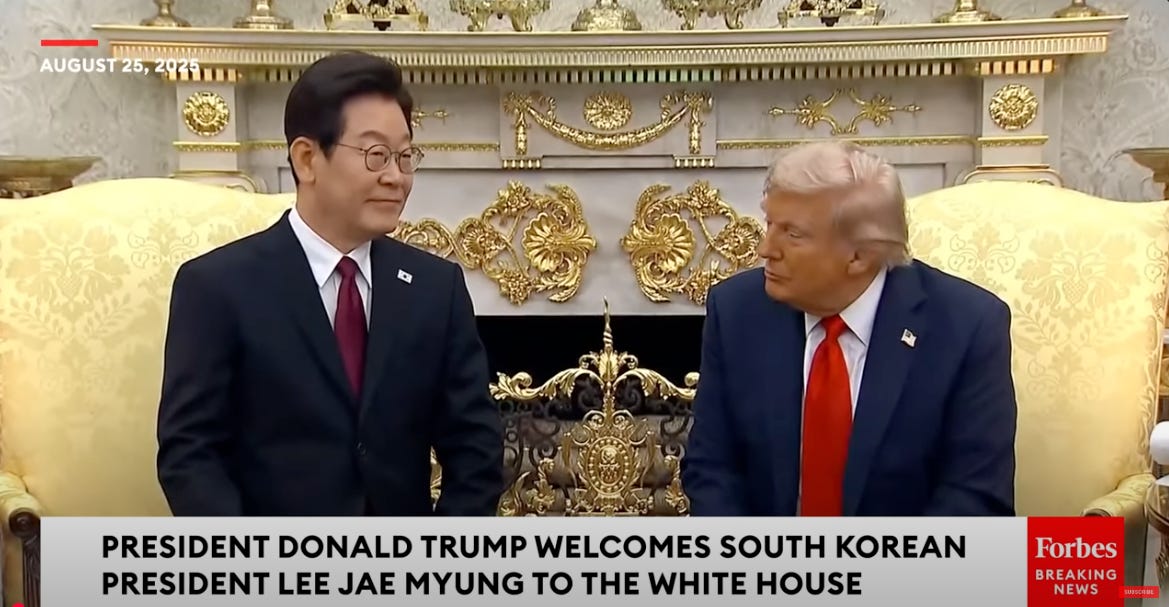Trump’s DMZ Delusions
From magnets to ‘comfort women’ and a Trump Tower in Pyongyang, the former president turned a tense Korea summit into a stream-of-consciousness sideshow.
Donald Trump sat beside the South Korean president this week and delivered what can best be described as a diplomatic variety show, equal parts nostalgia tour, campaign stump speech, and real estate sales pitch. What was supposed to be a sober bilateral conversation about security, trade, and North Korea instead became a meandering monologue about his “great relationship” with Kim Jong-un, his dream of building a Trump Tower in Pyongyang, and the mysterious global crisis of… magnets.
At one point, Trump recounted his famous DMZ walk, that made-for-TV moment in 2019 when he briefly stepped over the line dividing North and South Korea, shaking Kim Jong-un’s hand while the cameras rolled. To Trump, it remains one of his crowning achievements, proof that he alone could charm dictators into submission. This time, he bragged about seeing “more rifles than I’ve ever seen in my life” pointed at him through the windows of the border huts, but reassuring the room he “felt safe because I have a great relationship with Kim Jong-un.”
What Trump never seems to acknowledge is how much more dangerous the situation has become since then. North Korea has written South Korea off as a permanent enemy, tearing up decades of carefully worded reunification language. It has fired missiles across the DMZ, denounced U.S.–South Korean military drills as a “rehearsal for war,” and deepened military ties with Russia. Just this month, South Korean troops fired warning shots when North Korean soldiers crossed the demilitarized zone to build a barrier, prompting Pyongyang to accuse Seoul of a “serious provocation.”
Meanwhile, South Korea’s new president has been trying to cool tensions by shutting down propaganda loudspeakers and banning anti-North balloon leaflets, small gestures of de-escalation that Pyongyang has largely ignored or mocked. In short: the peninsula is volatile, the diplomatic atmosphere is brittle, and the risks are real. Against that backdrop, Trump’s nostalgia for his handshake photo-op reads less like statesmanship and more like dangerous self-delusion.He then pivoted, with no transition, into a grievance about clean energy: “They started to use solar panels that took over the land all over the Midwest where the farmers said, ‘What happened to my land?’ They’d have a 10 mile by 10 mile solar field that they couldn’t farm. The most valuable land farming land in the world, probably the most vibrant in the world. And they put solar plants all over the place. It’s ridiculous.”
And before anyone could ask him about the actual U.S.–Korea trade deal, he circled back to an entirely different subject: crime in Washington, D.C. “We have not had a murder in 11 days. It sounds crazy. I hate to say this in front of this gentleman who I respect because they don’t have murders for years, but we have not had a murder in 11 days. And that’s going to go on for a long time. And I would say that Washington, D.C. right now is much safer than Seoul.”
Then came the history lessons: Korea, Trump explained, was once a “very big, very powerful nation” that had gone to war with China “51 times” over the centuries, information he insisted he got straight from Xi Jinping. (There is no historical basis for the claim that Korea and China went to war 51 times.) After that revelation, he concluded that resolving tensions on the peninsula was “not going to be that easy.”
And because no Trump press event is complete without a culture-war jab, he revisited the unresolved trauma of Japan’s wartime atrocities. “All they wanted to talk about was comfort women,” Trump said of his past efforts to bring Japan and South Korea closer. “I thought that was settled a few times over the decades. But Korea was very stuck on that. You understand.” Japan, he insisted, was eager to “get on,” while Korea was the one holding grudges.
All this unfolded with South Korean President Lee Jae-myung sitting beside him, smiling tightly while Trump compared himself to a ‘peacemaker’ and declared, “If you become the peacemaker then I will assist you by being a pacemaker.” He then floated a future joint trip to Beijing, half-joking that they could save money and the environment by traveling together: “We’ll save energy. We’ll save, we’ll save a little, you know, the ozone. The ozone layer. Remember President Obama used to talk about the ozone layer and then he’d fly to Hawaii to play a round of golf in a 747.”
This is what passes for diplomacy in Trump’s America: a stream-of-consciousness jumble of half-remembered history, conspiracy chatter about church raids, and policy-by-gut-instinct. Serious questions about famine in Gaza or nuclear proliferation vanish into tangents about “cashless bail,” “deranged Jack Smith,” or whether to rename the Department of Defense back to the “Department of War.”
It’s not that Trump loses the thread, it’s that there never was a thread just an endless improvisation where every topic is a stage for his favorite role: Trump, the misunderstood dealmaker, adored by dictators, disrespected by Democrats, and forever auditioning for history.




So another world leader gets to see the madness up close.
He is only playing to his imbecilic audience